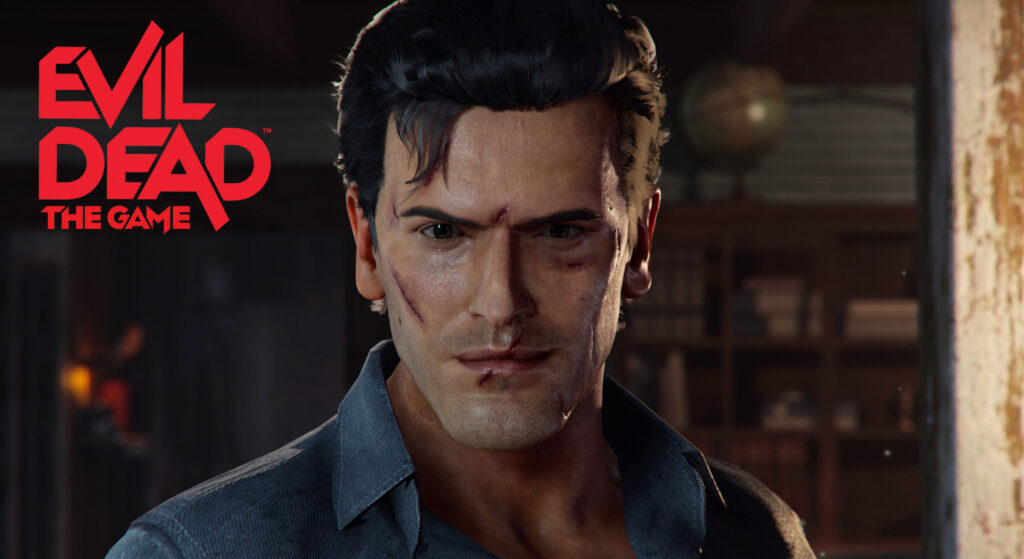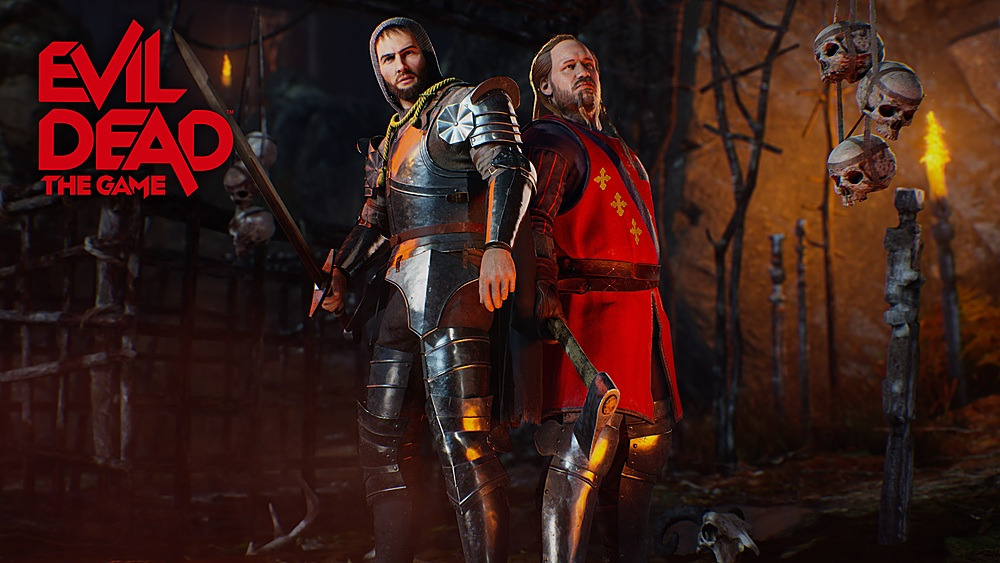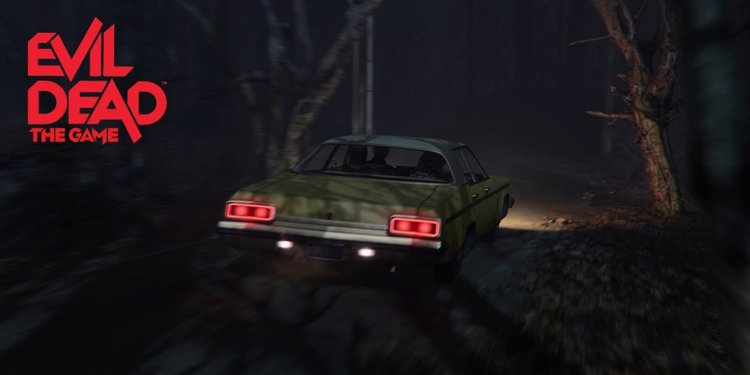Calling myself an Evil Dead fan would be a stretch. I have never seen the original, aptly-named The Evil Dead, and am too much of a scaredy-cat to check out the 2013 re-imagining, nor the recently released Evil Dead Rise. In regards to the television series Ash vs. Evil Dead, I watched the first episode and thoroughly enjoyed it, but was not drawn in enough to finish the season. That being said, I have seen Evil Dead II and Army of Darkness, and enjoyed both of them! These movies really did a good job at mixing horror with slapstick comedy, and while they can sometimes be a bit too over the top, Bruce Campbell’s iconic performance of Ash Williams will always be a delight to watch.
Despite my mediocre amount of support for this franchise, I’ve always been interested in giving Evil Dead: The Game a try. I’ve been engrossed in the asymmetrical horror genre ever since I watched Twitch streamers play Dead by Daylight on Twitch back in 2017. Once DBD finally released on consoles, I eagerly picked up a disc and proceeded to drop roughly 500 hours into the game over the next six years. More recently, my attention has been focused on The Texas Chain Saw Massacre, which I of course reviewed back in September. Even after finishing that review, I’ve been unable to put the game down. It’s a goofy, unbalanced mess at times, but there’s just something about the expertly managed tension of an asymmetrical horror game that gives me so much joy! However, I mentioned in my review that it’s highly difficult for games to survive in the asymmetrical horror genre, and this was unfortunately proven when developer Saber Interactive announced that they would cease developing content for Evil Dead: The Game, just over a month after The Texas Chain Saw Massacre launched. Despite how much I was enjoying escaping the Sawyer house, Evil Dead: The Game’s cancellation weighed on my mind. Now more than ever, I wanted to give the game a shot, even if just to try and understand why the game ultimately failed.

Before diving into how my matches went, I think it’s important to talk about how the game’s launch didn’t really set it up for success. While the Evil Dead fanbase is certainly loyal, the asymmetrical genre has always struggled with both gathering and retaining an audience to support a live service game. Evil Dead: The Game, an entry that already needed to gather as many fans as possible, was launched exclusively on the Epic Games store for PC players. I personally have no strong opinion on using Steam or Epic, but it’s safe to say that the Epic store is a divisive issue for PC gamers, which makes the already niche title a somewhat more difficult sell for potential PC players. Evil Dead: The Game also launched with a whopping price tag of $40, $10 higher than the original cost of Dead By Daylight. Nowadays, convincing gamers to drop money just to install a live-service multiplayer game can be a tough sell, with so many popular titles being free-to-play. I personally purchased the Game of the Year Edition for $25, which I considered a good deal since it included all of the expansion DLC, but certainly would have been far more hesitant to pay $40 just for the base game. While The Texas Chain Saw Massacre also costs $40, it at least was released as a day one Game Pass title, giving XBOX and PC players plenty of opportunity to try the title. Unfortunately, the questionable platform support alongside a steep price tag created a situation where Evil Dead: The Game did not have an opportunity to build as strong an audience on launch as the game deserved.
While Evil Dead: The Game didn’t launch under ideal conditions, I can say that the game is very fun! The core combat for Survivors is very engaging, regardless of whether you’re hacking waves of Deadites apart with an axe or taking potshots with a revolver. The combat isn’t the only part that makes Survivor fun – the robust looter-shooter mechanics and random objective locations make each match feel unique. Likewise, the macro-decisions players can make when playing as a Demon are very interesting. Each of the Deadite masterminds has a distinct playstyle that rewards map knowledge and creativity. Paired alongside the great gameplay is an excellent visual and audio presentation. The gorgeous graphics instantly help immerse players and set an appropriate amount of tension, regardless whether you are exploring the forests surrounding Knowby Cabin or the ruins of Castle Kandar. Many of the actors throughout the Evil Dead franchise returned to reprise their characters, which of course includes horror legend Bruce Campbell. The soundtrack is excellent as well, including an absolute banger of an original song from Method Man. All in all, Evil Dead: The Game is an audiovisual delight with robust combat mechanics that are often sorely missing from games in the genre.

Despite excellent gameplay and presentation, there are significant obstacles that kept Evil Dead: The Game from achieving more success, with one of the biggest roadblocks being new player onboarding. Evil Dead: The Game offers some simple tutorials to teach players how to play both Demon and Survivor, but neither does a particularly great job at teaching you about the intricacies of the online PVP. Survivor players can at least play the single-player modes and bot matches to get a knack for the combat, but this feature is bizarrely missing for Demon players. The game’s onboarding is so poor that the majority of learning I did for the game was watching months-old gameplay videos from the YouTuber Middi (Thanks, Middi!), just so I can understand what I should be prioritizing in online matches. New player experience is crucial for a game like this, considering how an experienced Demon player can isolate and slaughter a newbie Survivor within 5 minutes of the match, if the Survivor is not careful. Game knowledge isn’t the only thing newbies will need, either – Evil Dead: The Game has a grindy progression system that gives experienced players a menagerie of perks and stat buffs in relation to their character level. Even if a new player spent hours studying game guides and strategy videos, they will still be at a severe disadvantage coming in as a level one Survivor, with far lower damage and survivability. These unreasonable hurdles, while not impossible to bypass, unfortunately still create a significant challenge for any new player who wants to give this game a shot.
I say this often in my multiplayer game reviews, but it’s worth repeating: live-service games ultimately live or die by the quality and frequency of their content updates. Even if a multiplayer game has a solid foundation, consistent developer support is what keeps communities strong while bringing in both new and returning players. A quick glance at Saber Interactive’s Patch Notes tells the unfortunate story of Evil Dead: The Game’s post-launch support. In the year and four months that Evil Dead: The Game was receiving developer support, the game unfortunately only received 15 patches, only five of which occurred in 2023, with one patch simply being a hotfix for bugs. Evil Dead: The Game had five major content updates across the game’s fairly short lifespan, which is certainly a decent number. However, let’s take a closer look at the schedule for these content drops:
- May 13, 2022: Evil Dead: The Game Launches
- July 13, 2022: “Army of Darkness” Update
- September 8, 2022: “Evil Dead 2013” Update
- October 27, 2022: “Hail To The King” Update
- February 2, 2023: “Immortal Power” / Splatter Royale Update
- April 26, 2023: “Who’s Your Daddy” Update
- September 19, 2023: Evil Dead: The Game Ceases Development
When it comes to updating a live-service game, a consistent schedule helps players set reasonable expectations for when new content will be released. Looking at this timeline, you can see that Evil Dead: The Game sort of established a rough schedule of one major content update every two months, which is totally fine for a multiplayer game. This schedule continues until Saber Interactive releases the “Hail To The King” update, after which players had to wait over three months to access any new Evil Dead content. After the “Immortal Power” update, the development schedule seemed to return to normal for the “Who’s Your Daddy” update, after which there was no major content update during the five month gap before Saber Interactive canceled development for Evil Dead: The Game. With no update in nearly half a year, I can’t help but wonder if any Evil Dead players were even surprised when the game ultimately ceased development.

Now, I want to take us back to that February 2nd update, and why it probably took longer to release than the other content drops. You see, the February 2nd update included a new gameplay mode, which sounds exciting! Evil Dead: The Game is of course a combat-focused asymmetrical horror game, so fans had been clamoring for Saber Interactive to add in a PvE horde rush mode to capitalize on the fun fighting mechanics. Saber had different plans, instead releasing Splatter Royale, a 40-player battle royale mode complete with a unique class system and tons of new playable deadites to choose from. You may now be wondering the same question many Evil Dead fans were wondering – is there really that much overlap between battle royale players and asymmetrical horror fans? Is something the community even wanted? The answer seems to be a resounding no, as I spent roughly 20 minutes in queue for Splatter Royale and was unable to get into a single match. Deterred by a lack of community interest, I instead had to watch some old YouTube videos of Splatter Royale gameplay (thanks again, Middi!) to get a grasp on how the game mode was played. Suffice to say, what I witnessed served as a good explanation as to why matchmaking was so slow. Splatter Royale is totally fine from a gameplay perspective, but it’s ultimately a generic battle royale mode in a game that was already struggling with declining player numbers. When you look at leading battle royale titles like Fortnite: Battle Royale, Apex Legends, and Call of Duty: Warzone, one thing they have in common is that they’re all free to play. Despite this, Saber Interactive decided that battle royale fans who were interested in giving Splatter Royale a try would have to purchase Evil Dead: The Game in its’ entirety, regardless of whether they were interested in asymmetrical horror or not. The perplexing choice to introduce a battle royale mode to boost player engagement, all while excluding the typical battle royale enthusiasts through a $40 entry fee, unfortunately suggests that those in charge of development were woefully out of touch with the desires of gamers and Evil Dead fans alike. Considering how much time was likely spent designing this mode, and how I was unable to find a match a mere eight months after it launched, how can Splatter Royale be considered anything but a colossal waste of resources?
The demise of Evil Dead: The Game is a sad story, but ultimately a familiar one. We’ve seen this kind of gradual death happen before with other asymmetrical horror games. such as Video Horror Society and Friday the 13th: The Game, while other entries like Last Year still cling to life. These games each died for a mix of different reasons, but remain a reminder of how difficult it is to break into the asymmetrical horror genre. For now, Dead By Daylight still has a vice grip on the competition, but I will always root for alternate options in the genre, to both provide options for players and motivate developers to further innovate. When it comes to designing a competitive option, there are certainly lessons to be learned in examining the causes behind the death of a title like Evil Dead: The Game. Some reasons are obvious – Splatter Royale was a colossal waste of time and resources, all for a mode that the community had no particular appetite for. Unfortunately, the problems did not start nor stop there. Despite excellent gameplay, visuals, and sound design, Evil Dead: The Game not launching on Steam was ultimately a mistake. With very poor new player onboarding combined with a hefty price tag, it’s not hard to see how Evil Dead: The Game struggled to grow and retain its’ audience in the post-launch cycle as well. These problems may seem to have simple solutions, but they are mistakes that games continue to make. I’ve already admitted how much I enjoy playing The Texas Chain Saw Massacre, but even I have to admit it makes some of the same mistakes Evil Dead: The Game did, at least when it comes to both pricing and new player onboarding. Here’s hoping those are where the negative similarities end – I’d hate to have to write a post-mortem article about that game!


